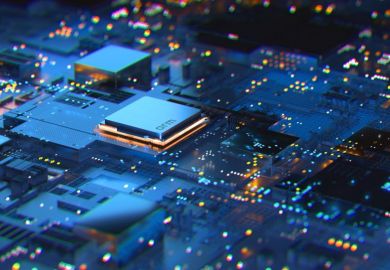On your desk you probably have a computer. It will be a general-purpose digital computer, able to do anything from word processing to searching for extraterrestial life. The idea that computers are universal is enshrined in a fundamental doctrine, the Church-Turing thesis, that basically claims that all computers are equivalent. Any proper computer can be programmed to simulate any other; they are universal. Any desktop computer can simulate being a word processor or anything else we can program it to do. If the thesis is pushed to the limits, hardliners would argue that the human brain is also a computer.
I am a hardliner, so I was shaken awake by an idea from this collection of papers, Molecular Computing . A universal computer has to be simple enough to program, and the trade-off for being simple means that programs are fragile. This sounds arcane, but it is borne out by experience: a small change to a working program often stops a device from working; it introduces a bug and the program fails. But if we try to design conventional programs to be robust, they will, by definition, be hard to change. Thus universal computers will never be good at learning or evolving, which require gradual change.
Biological systems such as immune systems, evolutionary systems, visual systems, brains and so on solve complex problems efficiently and involve a lot of learning to do so. Immune systems learn to recognise new diseases with surprising efficiency. They must, therefore, work in ways different from universal computers. Though they cannot be programmed conventionally, they can mutate, learn and evolve with ease.
In 1994, Len Adelman showed how DNA could solve a tricky conventional problem - finding a Hamiltonian tour - and the field of molecular computing blossomed. Molecular computers promise fantastic speed and new ways of approaching problems. They also pose challenges. Molecular computers are not universal; an immune system solves a complex problem quickly, but that is all it does. Setting up a wet computer so you can tell it a problem and read off the solution requires a lot of additional work. Adelman required a week for just one case of his problem (and his practical results have since been contested).
You can use your molecular computer only to solve a specific problem and you can typically use it only once, in one problem case. Molecular computers may solve problems with an alarmingly high error rate. Instead of being "universal", molecular computers are "instance" computers: they are good at one instance of a problem, and one problem type. If you set up a molecular computer to simulate a universal computer that can be programmed easily, you still lose out against the above trade-off, so it is probably a waste of time to try to build Turing machines with any hope of utilising parallelism to speed them up.
The advantages of molecular computers, at least for the time being, are outweighed by the difficulties of using them to do anything useful. There is more theory than practical success at the moment, though they have enormous potential for applications in medicine, farming, food and fingerprint recognition and forensic science.
Conventional problems are best handled by conventional computers; with molecular computers, we need to think differently. One trick is to use molecules to solve problems they are naturally good at solving. Thus molecular DNA computers are good at doing DNA-related things, and indeed some experiments have shown how the bacterium E.coli can be persuaded to be 32,000 times better at antibiotic resistance.
Another example is to make a fish-freshness sensor. You must measure many compounds and assess odour and taste to tell if a fish is fresh. This sort of problem is one that animals solve all the time, so there is good reason to hope that molecular computers could be built to do it, too.
Molecular computing is an inspiring subject, but Molecular Computing is a collection of independent chapters, written in a rather formal style. The book sticks to molecular computers, avoiding much of the background on other computers. You cannot read far without hitting a reference to some literature that is not explained. You have just got excited about fish freshness, say, when the paragraph finishes with the statement "a novel identification of freshness was performed", followed by eight literature citations needed for real understanding. If you are not going into research in molecular computing, the book's practical ideas and the deeper ideas will remain out of reach.
But there really is no alternative to it. The ideas are barely 20 years old and are already challenging our view of what we can do. Digital computers and molecular biology were two of the greatest scientific achievements of the 20th century; wet computers bring them together and will change the 21st century in ways we have not yet started to comprehend.
Harold Thimbleby is director of the University College London Interaction Centre.
Molecular Computing
Editor - Tanya Sienko, Andrew Adamatzky, Nicholas G. Rambidi and Michael Conrad
Publisher - MIT Press
Pages - 257
Price - £29.95
ISBN - 0 262 19487 2
Register to continue
Why register?
- Registration is free and only takes a moment
- Once registered, you can read 3 articles a month
- Sign up for our newsletter
Subscribe
Or subscribe for unlimited access to:
- Unlimited access to news, views, insights & reviews
- Digital editions
- Digital access to THE’s university and college rankings analysis
Already registered or a current subscriber? Login



